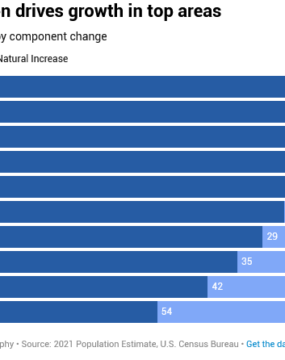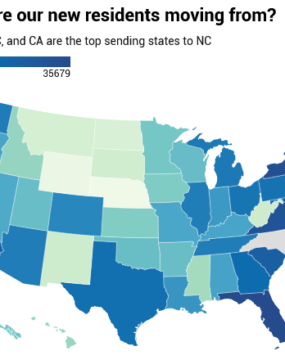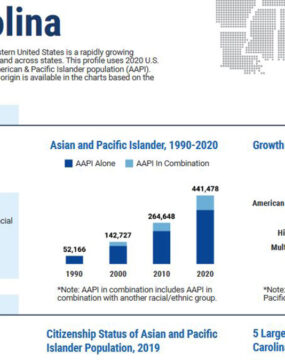Carolina Demographics
Keep up with our latest demographic insights

Today the US Census Bureau released 2022 population estimates for Metropolitan/Micropolitan Statistical Areas, incorporated cities and towns, and subcounty areas. These are annual population estimates based on the last decennial census and not actual 2020 Census counts. The annual Census estimates should not be confused with certified annual population estimates produced by the State Demographer of North Carolina which will be released later this year The press kit and data from today's release are available…

Dr. Michael Cline is the state demographer for North Carolina at the Office of State Budget and Management and has given us permission to re-post his content here. “We are a safe space where young people and families can be accepted and celebrated for who they are. It’s a safe space to be bilingual, bicultural, and to be yourself.” That is ISLA Executive Director Lwiza Escobar Garcia describing the role her organization plays in the…

From WoW Supermarket in Monroe, to Tienda Mi Pueblo in Durham; from Dirtbag Ales in Hope Mills to Tienda Los Nenes in Asheville; from Pura Vida Worldy Art in Charlotte to Diamante Arts & Cultural Center in Cary. The evidence of Hispanic population’s growth and cultural influence can be found across North Carolina. The Hispanic population in the state hasn’t just grown in the last three decades. Where the Hispanic population lives in North Carolina…

Dr. Michael Cline is the state demographer for North Carolina at the Office of State Budget and Management and has given us permission to re-post his content here. In 1989 a young couple moved to Greenville from Puerto Rico. Like many other young families who relocated to North Carolina, they were pursuing opportunity. The husband was embarking on his career (engineering), as his wife stayed home with their young daughter. Their daughter was soon joined…

Dr. Michael Cline is the state demographer for North Carolina at the Office of State Budget and Management and has given us permission to re-post his content here. In 2012 our office began preparing population estimates and projections of North Carolina’s Hispanic population because the demographic had grown exponentially since 1990 to become a significant part of the overall North Carolina population. These data included annual estimates and projections for Hispanic and Non-Hispanic population groups…

Nationally, there are 384 metropolitan statistical areas (MSAs), which are defined as economically integrated sets of counties with a core central city with a population of 50,000 or more. MSAs can be located within one state, or they can span across multiple states. They range in size from Carson City, Nevada (58,933) to the New York-Newark-Jersey City MSA (19,768,458) which crosses New York, New Jersey, and Pennsylvania. Within and including North Carolina, there are 17 unique metro regions, ranging from Goldsboro (116,835)…

From 2010 to 2020, North Carolina’s population grew by 9.8% with 49 of our 100 counties increasing in population. Among the largest gains: Charlotte and its suburbs, the Triangle region, and areas from Jacksonville (Onslow County) to Wilmington along the Atlantic Ocean. The map below shows a more detailed view of where we saw the biggest growth and losses amongst Census tracts. A Census tract is a unit of geographic measurement defined by the U.S.…

The majority of North Carolina’s growth over the past few decades has been from net migration, meaning more people moved here than moved away. We last looked at migration to North Carolina in June 2021, and wanted to see how things have changed over the past year. Where are our new residents moving from? Nearly 366,000 individuals moved to North Carolina in 2021, according to the U.S. Census Bureau’s American Community Survey (ACS). Most of those…

What’s behind the dramatic rise in the Southeast’s Asian Indian population? How can data points such as the median age of Asian American groups predict North Carolina’s future? How do the numbers match with growth trends of other populations like Latinx? A UNC Asian American Center collaborative study with Carolina Demography published in November 2022 will help researchers, scholars and communities answer those questions and many more as they plan for North Carolina’s future. The…

Nathan Dollar, PhD, has been named the new director of Carolina Demography, an applied demography center located within the Carolina Population Center at the University of North Carolina at Chapel Hill. Most recently Dollar served as a research scientist and project director for the Dynamics of Extreme Events, People, and Places (DEEPP) survey at the Carolina Population Center, where he investigated the factors that shape how people and communities in eastern North Carolina prepare for,…
Your support is critical to our mission of measuring, understanding, and predicting population change and its impact. Donate to Carolina Demography today.